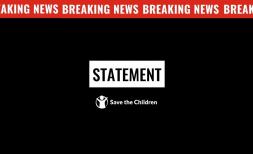Half of all refugee children are out of school leaving them exposed to exploitation and abuse

Monday 16th May 2016 - At least 3.5 million refugee children around the world are currently out of school, leaving them increasingly vulnerable to discrimination and potential abuse, as well as exploitation by traffickers or the pressure of entering into early marriage.
Refugee children are five times less likely to attend school than other children, with 50% of primary school-aged refugee children and 75% of secondary school-aged children completely left out of the education system, with none of the safe-guards that school environments provide. In 2015 alone the education of 80 million children was disrupted by humanitarian crisis.
“It’s a scandal that children are being denied the chance of a decent future because they are out of school. Without an education, these children face a bleak future. They are more likely to undertake perilous journeys to Europe and other parts of the world, and are also more likely to be married early, exploited, trafficked, and forced into work,” says Helle Thorning-Schmidt, CEO of Save the Children International.
“This is why, at the first ever World Humanitarian Summit, we are calling for no refugee child to be out of school for more than 30 days after being displaced.”

“The average length of time spent living as a refugee is now 17 years, meaning that millions of children and young people will miss out on some – if not all – of their education, severely diminishing the own future life chances and that of their families and communities,” she adds.
“Education sets children up for success. It provides refugee children with hope for the future in the places they are currently living as well as providing a sense of stability and normalcy for children who have lived through traumatic and stressful events. It also prepares children to learn the basic skills needed to rebuild and develop their countries if and when they return.”
Key barriers to education include financial and language issues; the need for many children to work informally to help support their families; lengthy bureaucratic processes and lack of documentation; limited school places; and the fact that developing countries host 86% of the worlds’ refugees and yet have the least capacity to cope with refugees and their complex short- and long-term needs.
The inaugural World Humanitarian Summit in Istanbul on 23rd and 24th of May is a significant opportunity to change the narrative on displacement and show compassion for some of the world’s most deprived, threatened children, according to Save the Children.

“Education in emergency situations and protracted crises (EiE) is chronically underfunded by an estimated $4.8 billion at present, and we simply won’t achieve the 2030 Sustainable Development Goals (SDGs) unless we all work together to tackle the barriers that prevent millions of refugee children from getting a quality basic education, much less stay true to the global pledge to ‘leave no one behind’,” says Thorning-Schmidt.
“At the Summit and beyond, we are asking donors and member states to provide better financial, legal, and political support for host-country governments to make sure that child refugees in their countries are in school and learning. This includes ensuring that all out-of-school refugee children have the opportunity to education, scaling up quality basic education for refugee children, and expanding early childhood care and education opportunities for refugees.
“Host countries have a role to play too. They must commit to ensuring refugee children in their countries are in school and learning, including making the necessary infrastructure available and removing the legal and financial barriers facing refugee children.”

The agency will also be calling for a ‘New Deal for Every Forcibly Displaced Child’, which includes IDPs, refugees and asylum seekers, all of whom are extremely vulnerable to separation from their families, neglect, physical or sexual abuse, death or injury, trafficking, or economical exploitation - with those on the move particularly exposed to these risks.
“We believe that every forcibly displaced child deserves a deal which guarantees their rights to a safe and productive life so, in addition to our commitments on education, we want to establish national and cross-border protection for children on the move between countries of origin, transit and destination,” says Thorning-Schmidt.
“We also encourage the implementation of existing internationally agreed norms and standards, including the UN Convention on the Rights of the Child, and UN Security Council Resolutions on children and armed conflict.”
READ OUR NEW DEAL FOR EVERY FORCIBLY DISPLACED CHILD
<ENDS>

NOTES TO EDITORS
- Save the Children is committed to helping ensure that Every Last Child survives and learns. We are doing whatever it takes to reach the world's most excluded children.
- The top refugee hosting countries are Turkey (11%), Pakistan (10.5%), Lebanon (8%), Iran (6.8%), Ethiopia (4.6%) and Jordan (4.5%).
- Half of all refugees come from Syria, Afghanistan and Somalia.
- Africa and Asia Pacific regions account for more refugees than the Middle East (excluding five million long-term Palestinian refugees).
- In a global survey commissioned for Save the Children’s Every Last Child campaign launch, 76% of respondents are concerned about discrimination against child refugees or children displaced by internal conflict; 77% of people think children fleeing conflict have as much right to an education as any other child; and 41% of people support increasing the number of child refugees that settle in their country; 28% oppose it.




